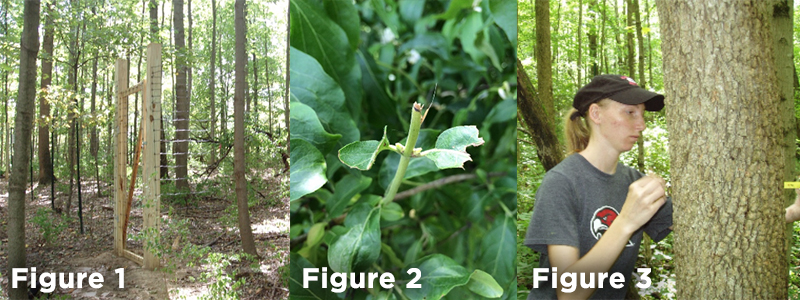David Gorchov (Biology)
Effects of an invasive shrub, Lonicera maackii, and a generalist herbivore, white-tailed deer, on forest floor plant community composition
I am a plant ecologist, and I have found the Natural Areas to be very valuable for both research and teaching. Every year the Field Ecology (BIO 433) makes use of the Natural Areas for some of its field labs. In recent years students have explored the effect of the invasive shrub, Amur honeysuckle (Lonicera maackii), on native and non-native earthworms, leaf litter fall and decomposition, and diversity of animals that live in the litter layer.
Most of my recent research has been on the invasion dynamics and impacts of non-native plants, and my students and I often use one or more of the Natural Areas for observations and experiments. Over the years, I have mentored two PhD students, nine MS students, and16 undergraduate students (IFig. 3) at Miami University on projects carried in whole or in part in the Natural Areas.
A major focus of my lab involves the interactions between invasive Amur honeysuckle shrubs and white-tailed deer, which are at much higher densities in the Natural Areas (and many parts of the U.S.) than they were before European-American settlement. This research has made intensive use of a set of five deer exclosures (Fig. 1), each paired with an unfenced control plot, which were installed in the Natural Areas in 2010 at the initiative of Dr. Thomas Crist.
Each exclosure is 20 x 20 meters, and in half we removed all honeysuckle, enabling us to tease apart effects of deer, honeysuckle, and their interaction. Doctoral student Jessica Peebles-Spencer found that both deer and honeysuckle negatively impacted the growth of native plants on the forest floor. Surprisingly, their combined effect was not significantly greater than the effect of either alone. This means that restoring forests will require both removing the invasive shrubs and reducing the density of deer.
But the shrub removal should not be done first – we have also found that honeysuckle shrubs provide sugar maple seedlings with some protection from deer browse. Conversely, deer mitigate the negative effect of honeysuckle by browsing its twigs (Fig. 2) and reducing the cover of low branches that shade smaller plants. In fact, MS thesis research by Kylie Martinod found that honeysuckle twigs comprise a major component of the diet of deer in the Natural Areas. Because much of this browse occurred in early spring, when honeysuckle has leafed out but native trees and shrubs are still leafless, we think honeysuckle provides a protein source at a lean time of year, and might keep the deer population at artificially high densities.
By David Gorchov
